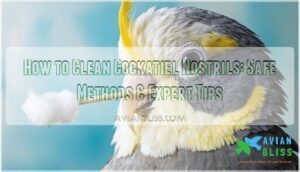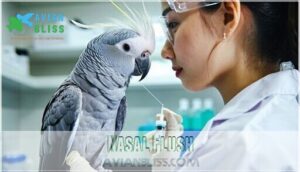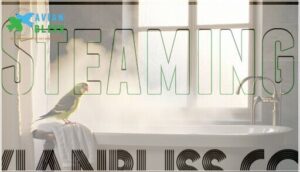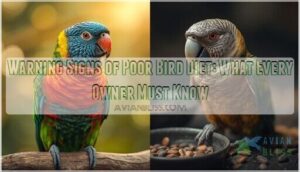This site is supported by our readers. We may earn a commission, at no cost to you, if you purchase through links.

Only intervene when you notice discharge, crusting, or obvious blockages that persist beyond a day. Never insert anything deep into the nostril opening, as you’ll risk pushing debris further back or damaging delicate nasal tissues.
If discharge appears yellow, green, or bloody, skip home cleaning entirely and contact your avian veterinarian immediately. Understanding the difference between normal nasal maintenance and concerning symptoms makes all the difference.
Table Of Contents
- Key Takeaways
- Cockatiel Nostril Care
- Cleaning Cockatiel Nostrils
- Nostril Problem Causes
- Nostril Cleaning Techniques
- Nostril Care and Treatment
- Frequently Asked Questions (FAQs)
- How to fully clean out nostrils?
- Do I need to clean my bird’s nose?
- How to clean a cockatiel and smell good?
- What to do if your bird has a stuffy nose?
- How do you clear a cockatiel’s nose?
- How do I clean my bird’s nose?
- Why is my cockatiels nose crusty?
- How to treat sinus infection in cockatiels?
- How often should a cockatiels nostrils be cleaned?
- Are nasal mites common in cockatiels?
- Conclusion
Key Takeaways
- You’ll only need to clean your cockatiel’s nostrils when there’s visible discharge, crusting, or blockages – healthy birds naturally maintain clear airways through normal preening and breathing.
- You should use a cotton swab dampened with warm saline solution and gently wipe around the nostril opening, never inserting anything deep to avoid pushing debris further back or damaging delicate nasal tissues.
- You must contact an avian veterinarian immediately if you notice yellow, green, or bloody discharge instead of attempting home cleaning, as these symptoms indicate serious infections requiring professional treatment.
- You can prevent most nostril problems by maintaining 50-60% humidity levels, providing vitamin A-rich foods like carrots and leafy greens, and ensuring excellent air quality through regular cage cleaning and avoiding toxic fumes.
Cockatiel Nostril Care
You’ll need to keep your cockatiel’s nostrils clean to prevent respiratory problems and maintain their overall health.
Proper nostril care involves recognizing normal appearance versus signs of blockage, infection, or irritation that require immediate attention.
Normal Nostril Appearance
Healthy cockatiel nostrils appear as small, oval-shaped openings positioned symmetrically on either side of the upper beak.
You’ll notice they’re typically clear and unobstructed, allowing for easy airflow during normal breathing patterns.
Key characteristics of normal cockatiel nostrils:
- Nostril Color: Clear to light pink without discharge or discoloration
- Nasal Shape: Small, oval openings with smooth edges and proper beak alignment
- Nostril Size: Proportionate to the bird’s head with maintained facial symmetry
Monitoring respiratory health issues is essential for maintaining healthy cockatiel nostrils.
Signs of Nostril Problems
Several red flags signal cockatiel nostril problems you shouldn’t ignore.
Watch for nasal discharge, nostril swelling, or visible nasal blockage that restricts airflow.
Your bird may develop breathing difficulties, persistent sneezing, or open-mouth breathing.
Respiratory issues often appear alongside wet feathers around nostrils, reduced vocalization, and lethargy indicating nasal congestion requiring immediate attention.
Importance of Nostril Cleaning
When you spot potential nostril problems, proper nostril hygiene becomes your bird’s first line of defense.
Clean nostrils support respiratory health and prevent breathing issues from escalating.
Regular cockatiel nostrils cleaning maintains nasal balance through these key benefits:
- Airway clearance removes debris before blockages form
- Infection prevention stops bacteria from establishing colonies
- Comfort enhancement eliminates irritation and discomfort
- Early detection reveals developing problems during routine nostril cleaning techniques
Bird nostril cleaning isn’t just maintenance—it’s preventive healthcare that keeps your cockatiel breathing easily.
Cleaning Cockatiel Nostrils
Cleaning cockatiel nostrils requires a delicate touch and proper technique to maintain your bird’s respiratory health. You’ll need warm water, cotton swabs, or soft cloths for safe nasal hygiene practices.
Never force objects deep into the nostril – this can cause serious injury. Start by gently moistening a cotton swab with warm water. Carefully wipe around the external nares to remove visible debris or crusts.
For stubborn nostril blockage, apply a single drop of sterile saline solution to soften material before cleaning. Watch your cockatiel’s body language during beak cleaning sessions. Signs of stress include panting or struggling, which means you should stop immediately.
Some birds naturally clear their own nostrils through sneezing after gentle cleaning. Proper feather care around the nostril area prevents debris accumulation. Regular cleaning cockatiel nostrils prevents respiratory complications, but limit frequency to avoid irritation.
These nostril cleaning techniques support overall bird nostril cleaning and cockatiel nose care routines. Regular checks for respiratory health issues can help identify potential problems early on.
Nostril Problem Causes
Understanding what causes nostril problems helps you spot issues early and take proper action.
Common culprits include bacterial infections, fungal growth, vitamin deficiencies, poor humidity levels, and airborne irritants that can block or inflame your cockatiel’s delicate nasal passages, which can be caused by airborne irritants.
Keep those tiny airways clear – your cockatiel’s health depends on it.
Bacterial Infections
Gram-negative bacteria like Pseudomonas contaminate cockatiels’ nostrils through poor hygiene, causing swollen, crusty openings with yellow discharge.
You’ll notice labored breathing and persistent sneezing in affected birds.
Bacterial cultures confirm infection diagnoses, while topical antibiotics like enrofloxacin resolve most cases within 7-14 days when combined with improved air quality, leading to a successful treatment of the bacterial infection.
Fungal Infections
In damp environments, fungal spores like Aspergillus can invade your cockatiel’s respiratory system, causing aspergillosis and stubborn sinus infections.
You’ll notice white or yellow discharge from nostrils, persistent sneezing, and breathing difficulties.
Fungal infections require prompt veterinary fungal treatment since they’re trickier to eliminate than bacterial issues, making proper cockatiel nostril cleaning essential for preventing serious avian respiratory health complications, which can be challenging due to the persistent sneezing.
Vitamin a Deficiency
Poor nutrition ranks as your cockatiel’s biggest enemy when fighting nasal problems. Vitamin A deficiency affects up to 35% of pet birds with respiratory issues, particularly those on seed-only diets lacking essential nutrients.
Your bird’s Vitamin Needs require immediate Dietary Changes to prevent nostril complications.
- Seed Diets provide less than 12% vitamin A absorption compared to balanced nutrition
- Nutrient Supplements like sweet potatoes offer over 8,000IU/kg vitamin A content
- Balanced Nutrition through commercial pellets increases bioavailability to 70%
- Cockatiel nostril cleaning becomes necessary when vitamin A deficiency causes thickened secretions
- Bird nasal hygiene improves dramatically with proper cockatiel respiratory health through nasal discharge management
Humidity Levels
Your cockatiel’s respiratory system requires balanced humidity levels to maintain ideal nasal health.
Low humidity from heating systems dries nasal passages, while humid environments can promote bacterial growth.
Both extremes create breathing issues. Maintain 50-60% humidity using a hygrometer for moisture control.
Proper air quality prevents respiratory complications and supports your bird’s natural cockatiel nostril care through effective nasal irrigation functions.
Understanding cere health issues is also essential for overall bird well-being.
Airborne Toxins
Toxic fumes from cleaning products, candles, and air fresheners create indoor toxins that irritate your cockatiel’s sensitive respiratory system.
Chemical exposure leads to inflammation and mucus production in nasal passages.
Air pollution and particle matter from dust, aerosols, and cooking smoke compound these effects, compromising your bird’s natural nasal cleaning ability.
These airborne toxins require more frequent nostril care interventions.
Nostril Cleaning Techniques
When you encounter nostril blockages in your cockatiel, several safe cleaning techniques can help restore normal breathing without causing trauma to delicate nasal tissues.
These methods range from gentle external cleaning to veterinarian-supervised procedures, each designed to address different types and severities of nasal obstructions.
Nasal Flush
Professional nasal flush procedures require veterinary expertise using sterile saline solution and proper restraint.
Your vet instills warm buffered crystalloid into each nostril while positioning your bird’s head downward to prevent aspiration.
This flush techniques method clears debris effectively and allows examination of collected fluid for pathogens, making it superior to home decongestant methods.
Regular checks for bird respiratory health can help identify potential issues before they become severe, ensuring the overall bird respiratory health and preventing complications from nasal discharge.
Steaming
When steaming becomes your go-to technique, you’re harnessing warm mist to provide breathing relief for your feathered friend. This nasal steaming method offers gentle avian respiratory care through steam inhalation.
Utilizing proper nasal steamer devices can enhance the effectiveness of the treatment.
Follow these steam therapy steps:
- Run hot shower to create humid bathroom environment
- Place cockatiel 3-4 feet from steam source for 10-15 minutes
- Monitor for overheating or respiratory distress during treatment
- Allow natural sneezing to clear loosened debris afterward
Spray Bottle
A fine mist from a clean spray bottle provides gentle humidity control for cockatiel nostril cleaning.
Use distilled water and maintain proper spray frequency—light misting twice daily helps soften debris without overwhelming your bird.
Clean the bottle weekly to prevent bacterial growth.
Position yourself at arm’s length during misting techniques, allowing natural sneezing to clear loosened particles from nasal passages, which helps with gentle humidity control and ensures proper spray frequency.
Tissue Paper
Around your feathered friend’s nostrils, soft tissue paper provides gentle absorption for excess moisture and debris.
Use high-quality, soft textures designed for delicate surfaces when performing cockatiel nostril cleaning. These gentle wipes absorb mucus effectively without irritating sensitive nasal tissues.
Choose unscented paper quality materials specifically for nasal cleaning methods and cockatiel nasal hygiene to guarantee safe nostril cleaning tools.
Proper beak cleaning methods are also vital for maintaining overall bird health and hygiene.
Nostril Care and Treatment
When your cockatiel’s nostrils need attention, you can safely address minor issues at home while knowing when professional care is necessary.
Proper nostril care combines gentle cleaning techniques with preventive measures to maintain your bird’s respiratory health.
At Home Care
You’ll start your cockatiel nostril care by gently cleaning with moistened cotton swabs and warm water.
Home remedies like saline drops help loosen debris naturally while maintaining proper nostril hygiene.
Focus on cage maintenance, air quality improvement, and bird nutrition with vitamin A-rich foods to prevent blockages from developing further.
Regular use of cockatiel care products can also aid in maintaining your bird’s overall health.
Veterinary Treatment
When serious cockatiel respiratory issues persist despite home care, professional avian veterinary care becomes essential.
Veterinary diagnosis through medical tests can identify underlying infections requiring specialized treatment.
- Vet diagnosis determines if bacterial, fungal, or parasitic infections cause nasal discharge
- Medical tests like radiographs and endoscopy reveal hidden respiratory problems
- Avian therapy includes antibiotics, antifungals, or antiparasitic medications as needed
- Emergency care and bird surgery may address severe blockages or chronic sinusitis
It’s vital to understand respiratory infection risks to provide proper care for your cockatiel.
Preventing Nostril Problems
Your cockatiel’s nostril hygiene depends on proactive diet management and environmental controls.
Maintain 40-60% humidity levels while ensuring excellent air quality through regular cage cleaning and HEPA filtration.
Provide vitamin A-rich foods like carrots and leafy greens to strengthen respiratory health.
Stress reduction through proper cage placement away from drafts supports natural nasal defense mechanisms and prevents blockage formation.
Monitoring Nostril Health
Regular nostril inspection prevents minor issues from becoming major respiratory problems. You’ll want to check your bird’s nares during routine health checks.
Daily monitoring checklist:
- Clear airflow – Watch for unobstructed breathing patterns
- Dry, clean nares – No discharge or crusty buildup present
- Symmetrical appearance – Both nostrils look identical in size
- Normal behavior – Active vocalization and regular grooming
- Steady breathing – No open-mouth or labored respiratory effort
Watch for subtle nostril symptoms that signal developing avian nostril issues. Cockatiel nostril health changes quickly, so consistent nasal balance monitoring helps maintain ideal avian nasal health.
Frequently Asked Questions (FAQs)
How to fully clean out nostrils?
Something’s blocking your feathered friend’s breathing passage—here’s the safe approach.
Moisten a cotton swab with warm water, then gently wipe around the nostril opening.
Don’t insert deeply or force debris out, as this risks injury.
Do I need to clean my bird’s nose?
Generally, you don’t need to routinely clean your cockatiel’s nostrils.
Healthy birds naturally maintain clean nares through self-grooming.
Only intervene if you notice visible blockages, discharge, or breathing difficulties requiring gentle, veterinary-guided cleaning techniques.
How to clean a cockatiel and smell good?
Want your feathered friend fresh and fragrant? You’ll need gentle bird-safe shampoo, lukewarm water, and patience. Mist lightly, avoid soaking, then towel-dry carefully—never use human products or blow dryers.
What to do if your bird has a stuffy nose?
Check your cockatiel for discharge, breathing difficulties, or swollen nostrils. Increase humidity with gentle misting, make certain of proper ventilation, and consult an avian veterinarian immediately for persistent symptoms.
How do you clear a cockatiel’s nose?
Use a damp cotton swab with warm water to gently remove debris from your cockatiel’s nostrils. Don’t push deep—let the bird sneeze out loosened material naturally.
How do I clean my bird’s nose?
Cleaning your bird’s nostrils requires gentle technique and proper tools. Use a damp cotton swab with warm water to softly remove visible debris, avoiding deep insertion to prevent injury.
Why is my cockatiels nose crusty?
Your cockatiel’s crusty nostrils typically result from vitamin A deficiency, mites, dried mucus buildup, or environmental factors like dust and low humidity affecting their delicate nasal passages.
How to treat sinus infection in cockatiels?
Respiratory infections affect up to 20% of pet birds annually.
You’ll need immediate veterinary care for sinus infections, as they require prescription antibiotics, antifungal medications, or anti-inflammatory treatments depending on the underlying cause and severity.
How often should a cockatiels nostrils be cleaned?
Only clean your cockatiel’s nostrils when you notice visible blockages or debris.
Healthy birds naturally maintain clear airways through self-grooming, so routine cleaning isn’t necessary and may cause stress or irritation if done too frequently.
Are nasal mites common in cockatiels?
Nasal mites aren’t particularly common in cockatiels, but they can occur.
You’ll typically see scaly-face mites causing crusty sores around the nares rather than inside them.
If you notice unusual crusting or swelling, consult your avian vet for proper diagnosis and treatment.
Conclusion
Like a bird’s respiratory system that functions as a delicate, interconnected network, your cockatiel’s nostrils require gentle, informed care.
Studies show that 80% of respiratory issues stem from improper cleaning techniques. Remember, learning how to clean cockatiel nostrils safely protects your feathered companion’s health.
You’ll prevent serious complications by using proper saline solutions and recognizing warning signs early. Most importantly, you’ll know when professional veterinary intervention becomes necessary, ensuring your cockatiel breathes easily for years ahead.









